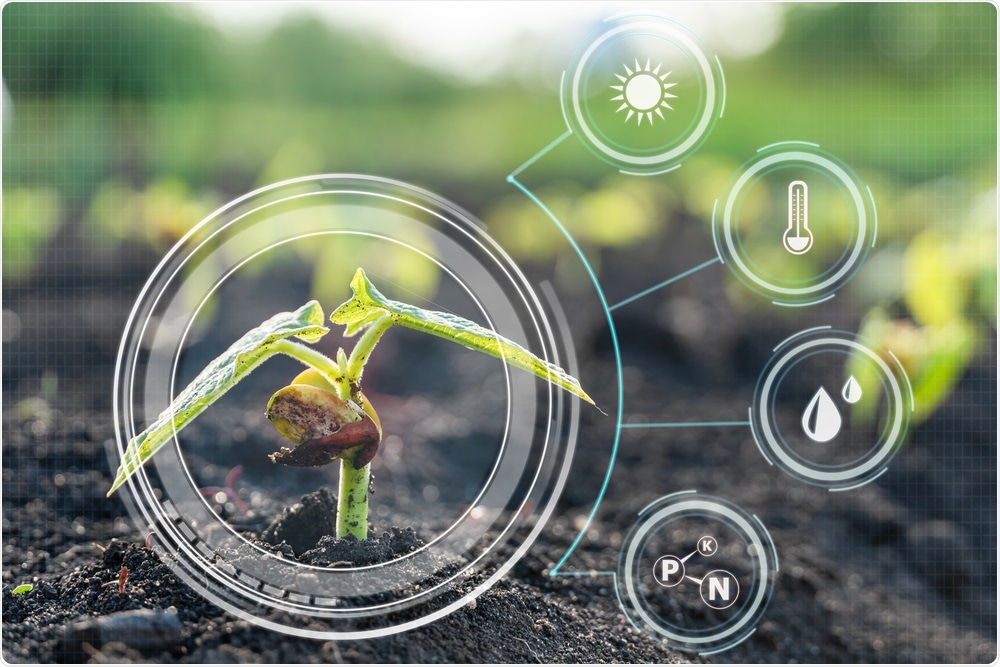The agricultural field serves as a testing ground for fast-advancing technologies such as unmanned aerial vehicles (UAVs) and image processing techniques that are rapidly becoming inevitable tools for efficient plant phenotyping (evaluation of observable plant traits) and precision agriculture.

Image Credit: Leonid Sorokin/Shutterstock.com
Experts can use aerial images acquired from UAV-mounted multispectral cameras to quickly gain versatile information like plant height, nitrogen and chlorophyll content, and the occurrence and extent of plant diseases.
Although UAV-enabled applications have shown tremendous potential, certain bottlenecks restrict their accuracy and efficiency. UAVs are devices that depend on compact batteries for energy source and thus have a very low autonomy. Therefore, the time needed to recharge or swap the battery can acutely hamper their data throughput for adequately large fields.
At present, this issue can only be overcome by compromising on either the quality of the 3D reconstruction of the target surface or the spatial resolution. To solve this issue, the UMT CAPTE group from INRAE and HIPHEN, France developed a new image acquisition approach.
A recent study by the team reported in Plant Phenomics describes their strategy that involves using (at least) two cameras with varying focal lengths mounted on the same UAV. The researchers used sufficient image processing algorithms and managed to co-register (i.e., align and adjust) images from various spectral bands, such as those captured with varying focal lengths and at somewhat different angles.
This enabled the researchers to create a 3D dense point cloud of the soil and crops, which was then used to develop an “orthoimage” (an aerial photograph corrected geometrically for even scale) of the whole field and extract plant heights.
The main advantages of using such a “double swath configuration” with two varying focal lengths are numerous. Firstly, the quantity of images needed to cover the whole target area for a specified predetermined overlap and minimum spatial resolution is typically halved. Thus, both the flight time and processing time are decreased by a factor of at least two.
Moreover, the experimental findings revealed that the double swath strategy was better at “georeferencing,” or mapping an aerial photo’s internal coordinates using the corresponding coordinates in physical space.
We found the best improvement in georeferencing to be for the Z dimension; about 6 cm. This was mainly due to the availability of larger view angles.”
Dr Wenjuan Li, HIPHEN and INRAE
Lastly, this specific research also offered a valuable understanding of how to efficiently leverage multispectral cameras for calculating plant height as well as the significance of the quality of point clouds for this purpose.
The strategy was applied successfully using Airphen, a commercially available multispectral camera, in various research and industrial projects for precision agriculture and plant phenotyping. Thanks to these advancements, Dr Li and her colleagues from INRAE and HIPHEN hope that there will be a bright future for UAVs and the team’s approach in precision agriculture.
Improving flight efficiency while preserving good accuracy is a critical question in both research and industrial fields. Our proposed double swath configuration offers potential guidelines for future camera and flight path design, as well as the simplification of data processing.”
Dr Wenjuan Li, HIPHEN and INRAE
Further tuning of this method will open a new door for aerial precision agriculture and plant phenotyping.
Source:
Journal reference:
Li, W., et al. (2021) A Double Swath Configuration for Improving Throughput and Accuracy of Trait Estimate from UAV Images. Plant Phenomics. doi.org/10.34133/2021/9892647.